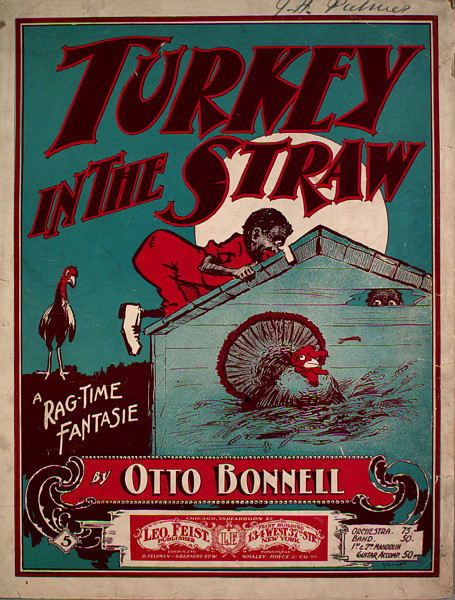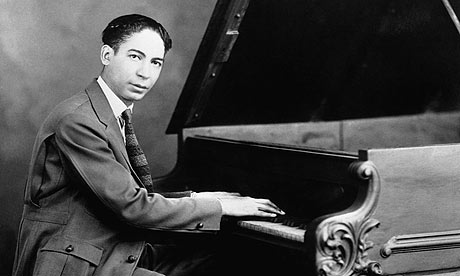
There is no song in American history which represents America more than "Turkey in the Straw" and there is no song which America is more ashamed of.
Everyone knows the tune "Turkey in the Straw", but in case you need reminding, here's some random YouTube fella playing it on the fiddle:
It's pretty much the perfect melody and those few notes say more about America than the entire wanking country music scene for the last 40 years. The legendary tune has existed since at least the 18th century and has its roots in irish music, but when it came over to America it became a hit on the newly arisen blackface ciruit. To cash in on the success of the ur-blackface number, "Jump Jim Crow", around 1830 the melody was first named and published as "Old Zip Coon".

I do have to say that, compared to later negro parodies, Zip Coon is actually a pretty suave-looking guy.
There is a tendency with such a well known song for people to try and "reinterpret" it when they play, but the best straightforward version of the song I've heard is by the 2nd South Carolina String Band from, oh yes, 1997. The 2nd South Carolina String Band specialise in accurate recreations of Civil War era music and their version of "Zip Coon" is pretty much as good as it gets:
The song was originally written with the chorus: "O Zip a duden duden duden zip a duden day!" Bob Dylan, eat yer heart out!
It was one of the most popular minstrel songs of its day along with the likes of "Dixie" and "Oh Susanna". In 1861, the song was published again, with new lyrics by Dan Bryant and was first called "Turkey in the Straw". This is the title most associated with it today.
Both "Old Zip Coon" and "Turkey in the Straw" are nonsense songs - there is no working class message, no racial or social message, no romance - just complete meaningless nonsense. The lyrics have been altered throughout the ages, but here's a few examples:
Did you ever go fishin'
On a warm summer day
When all the fish
Were swimmin' in the bay
With their hands in their pockets
And their pockets in their pants
Did you ever see a fishie
Do the Hootchy-Kootchy Dance?
OR
Well, if frogs had wings and snakes had hair,
And automobiles went flyin' thro' the air,
Well, if watermelons grew on a huckleberry vine,
We'd still have winter in the summer time.
OR
O it's old Suky blue skin, she is in lub wid me,
I went the udder arter noon to take a dish ob tea;
What do you tink now, Suky hab for supper,
Why chicken foot an possum heel, widout any butter.
OR
Sings posom up a gum tree an cooney in a holler,
posom up a gum tree, cooney on a stump,
posum up a gum tree, cooney on a stump,
posum up a gum tree, cooney on a stump,
Den over dubble trubble, Zip Coon will jump.
Some of the strangest lyrics ever written were written in the 19th century - Bob Dylan's "surreal" lyrics on the likes of "Blonde on Blonde" ain't got shit on them. A fact which Bob himself has acknowledged.
The song has entered into the public consciousness in many ways. One of the most well known of course is the classic Disney cartoon Steamboat Willie from 1928, the first Disney cartoon to use synchronised sound, in which Mickey plays the song using the organs of various animals:
Legendary stuff. The song was first recorded in the 1890's (possibly 1891!) by Billy Golden. Here's a link to public domain upload from the Internet Archive:
http://www.archive.org/details/TurkeyInTheStrawByBillyGolden1890s
Shockingly, the sound quality isn't great, although it's surprisingly good for the 19th century. Here its played in vaudeville style on the piano with Billy going mental, shrieking and laughing like a nutter. Billy Golden was one of the first great stars of the vaudeville circuit and recorded numerous popular songs.
"Turkey in the Straw" was most associated with blackface until the hillbilly scene took off; it then became most associated with that other most ridiculed American minority, the southerner and the song became a by-word for rural life and hickishness. Take a look at this music video fron 1942, by the Schnickelfritz Band:
I'm going to make a bold statement here, because I'm drunk: "Turkey in the Straw" is the GREATEST MELODY IN HUMAN HISTORY. You may think I'm crazy, but just keep listening to it. It's simple and yet its complex and its SOOOOOOOOOOOOOO catchy and memorable. Yet unlike many other folk songs, you won't find this played to an American flag, by a brass band, or sung at a political rally. The most you'll ever hear is an Ice Cream truck
Its the song that America likes to push into a corner - its a point of guilt and embarrassment, representing everything that they like to forget, like blackface minstrelry and hillbillies. It is not considered an artistic song, or an important song. It's considered lightweight and childish. But it's this shameless pretentiousness that highlights its genius. They may play "Glory, Glory Hallelujah", "Star Spangled Banner", "God Bless America", but it's "Turkey in the Straw" and "Old Zip Coon" and THAT melody that really embodies America and says everything you need to know and feel.
It is perfection. It should be treasured.
So, everyone together:
De de, de-de de, de de deh deh, deh deh deh, de, deh...







